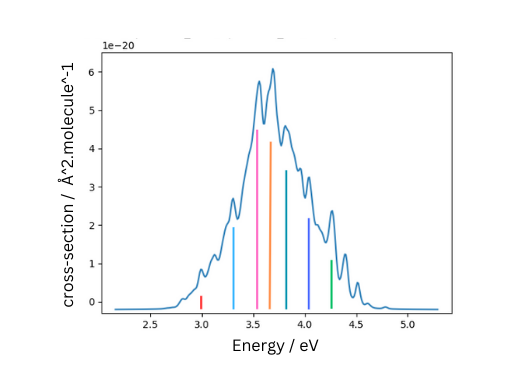
Photochemistry
The Nuclear Ensemble Approach
The Atmosphere is an extremely complex environment with many reactions occuring at the same time, some of those reactions are spontaneous on exposure to light. For example, smog is a result of light induced photochemical reactions between nitrous oxides (NOx) and other volatile organic compounds (VOCs). Traditionally, the reactive properties of such volatile gasses are measured empirically, however this is extremely difficult due to their unstable nature. So how do scientists predict the interaction of molecules with light?
Recent advances in Computational Chemistry have enabled the insilico calculation of photochemical properties, using Quantum Chemistry methods to predict quantities such as the molecular photoabsorption cross-section. One fascinating method called the Nuclear Ensemble Approach (NEA), has revolutionized our ability to calculate these interactions efficiently. This method bridges the gap between complex quantum mechanical calculations and practical spectroscopy.
What is the Nuclear Ensemble Approach?
Imagine trying to predict how a molecule will absorb light. The traditional quantum mechanical way would require solving the Schrödinger equation for both ground and excited states, considering all possible vibrational and electronic states - an extremely complex task! The Nuclear Ensemble Approach offers a clever shortcut that gives us surprisingly accurate results by sampling the ground state wavefunction and using these samples to predict the photoabsorption spectra.
The Quantum Mechanical Foundation
At its core, NEA is based on the reflection principle from quantum mechanics. Instead of calculating the full quantum mechanical problem, we:
- Sample the ground state quantum wavefunction
- Calculate vertical excitations for each sample
- Combine these excitations into a spectrum
This approach cleverly avoids calculating the excited state wavefunction, which is typically the most computationally expensive part of traditional methods.
Essentially: We’re calculating how likely the molecule is to absorb light at different energies, taking into account how the molecule’s structure affects its interaction with light.
Applications
The presented method stands as a reliable and relatively cheap way of predicting photoabsorption cross-sections of Volatile Organic Compounds, making it extremely attractive to Atmospheric Chemists. As the calculation of photoabsorption cross-sections plays a crutial role in the evaluation of photolysis rate of such molecules in the atmosphere, and they are extremely difficult to deteremine empiricaly, the use of insilico methods is becoming more and more viable. To further drive this, optimal sampling has been proposed by Stepan Srsen, whereby a reduction of the sample is performed to improve the efficiency of the overall calculation.
Practicality vs. Precision
While the NEA might not provide the extremely fine details that more complex quantum mechanical methods offer, this trade-off is often exactly what atmospheric chemists need. In studying atmospheric processes, we’re typically more interested in the overall shape and intensity of absorption bands rather than their precise vibronic structure. The NEA’s ability to efficiently calculate photoabsorption cross-sections for unstable VOCs has made it an invaluable tool in atmospheric chemistry. When combined with optimal sampling techniques, it provides a practical pathway for studying these elusive molecules that are so crucial to our understanding of atmospheric processes, from urban smog formation to global climate chemistry.
Key Takeaway: The Nuclear Ensemble Approach represents a significant breakthrough in computational photochemistry, offering atmospheric scientists a practical tool for studying light-molecule interactions that were previously either computationally intractable or experimentally challenging to measure.
Other Blog posts
Konstantin N
BLOG
Nuclear Ensemble Approach NEA photoabsorption cross-sections Quantum Chemistry Atmospec Python